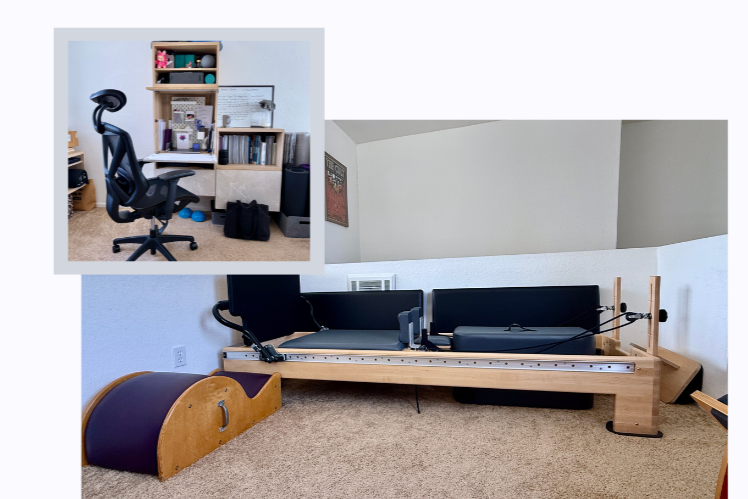Mindful Movement: Designing Your Home or Office Space for Pilates and Wellness
In today’s world of desk jobs, back-to-back video calls, and endless screen time, our homes and offices can unintentionally promote stillness. The result? Tight muscles, poor posture, and low energy. By designing a movement-friendly space — especially one that supports Pilates at home — you can create an environment that keeps you active, aligned, and energized all day long.
Start with Flow and Function
The first step in creating a movement-friendly home or office is planning your space for easy movement flow. Clear pathways so you can seamlessly shift from your desk to a mat for a quick stretch or a set of beginner Pilates exercises. Even in small spaces, decluttering makes room for standing breaks, posture resets, or a mini home Pilates workout.
Choose Multipurpose Pilates Equipment
When designing your space, look for Pilates equipment for small spaces that’s easy to store but versatile enough for a variety of exercises:
Pilates Mat: Essential for all levels, from beginners to advanced practitioners.
Resistance Bands: Perfect for core strength, upper body toning, and posture exercises.
Small Ball: Adds challenge and instability to any mat workout.
Pilates Ring: Similar to the ball, adds challenge and some resistance to any mat workout.
Pilates Chair or Reformer (if space allows): Great for longer Pilates workouts at home.
Keep your gear visible — you’re more likely to stick with home Pilates workouts if the equipment is always within reach.
Design for Better Posture
One of Pilates’ biggest benefits is improved posture and spinal alignment. Support this by:
Ergonomic Seating: Choose a chair that encourages upright posture with feet flat on the floor.
Standing Desk: Alternating between sitting and standing helps activate your core.
Wall Space: Use it for wall roll-downs, shoulder openers, and Pilates exercises for flexibility.
Create Micro-Movement Zones
Movement doesn’t have to happen in long blocks. Dedicate a corner for “movement snacks” during the day:
• Two minutes of Pilates spine stretches
• Wall push-ups for posture
• Standing leg lifts to activate glutes
• Short Pilates with resistance bands sequences
These small bursts keep your body engaged, your core strong, and your mind alert.
Enhance with Light, Air, and Inspiration
Pilates is a mind-body practice, so set the mood with elements that promote focus and calm. Let natural light in when possible, use plants to improve air quality, and choose energizing yet soothing colors. You might even hang Pilates anatomy prints or motivational quotes to inspire you to roll out your mat.
Make Movement a Daily Habit
A movement-friendly space is only as good as the habits you practice in it. Schedule breaks into your workday, set reminders to stretch, and try a short Pilates workout for beginners in the morning or between meetings. Over time, moving more becomes second nature.
Designing a home or office space that encourages movement — especially with Pilates at home — isn’t just about looking good. It’s about creating a daily environment that supports strength, posture, flexibility, and overall wellness.
⸻
FAQ: Designing a Movement-Friendly Home or Office Space with Pilates
1. What equipment do I need for Pilates at home?
For a basic home Pilates workout, you’ll want a quality mat, resistance bands, and a small stability ball. If you have more space, consider adding a Pilates chair or reformer. These tools allow you to do a wide variety of beginner Pilates exercises as well as more advanced routines.
2. How do I make my office more movement-friendly?
Start by clearing space for micro-movements like spine stretches, wall push-ups, and standing leg lifts. Add ergonomic furniture, a standing desk, and keep Pilates equipment for small spaces — like resistance bands — close by for quick use during breaks.
3. Can I do Pilates in a small home or apartment?
Absolutely. Many Pilates at home exercises require only a mat and a few feet of space. Opt for foldable or compact equipment, such as resistance bands or a portable Pilates chair, to maximize functionality without crowding your room.
4. How often should I do Pilates at home?
For most people, 3–5 sessions per week provides noticeable improvements in strength, posture, and flexibility. Even adding short Pilates workouts for beginners during the workday can help counteract the effects of sitting.
5. What are the benefits of adding Pilates to my workday?
Incorporating Pilates into your home or office routine can improve posture, strengthen your core, reduce back pain, and increase energy levels. It also boosts circulation and mobility, which helps offset the strain of prolonged sitting.

